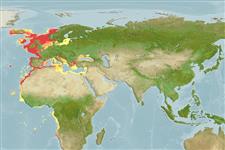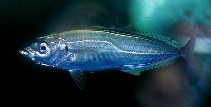Add your observation in Fish Watcher
| Native range | All suitable habitat | Point map | Year 2050 |

|
| This map was computer-generated and has not yet been reviewed. |
| Trachurus trachurus AquaMaps Data sources: GBIF OBIS |
Upload your photos and videos
Pictures | Videos | Stamps, coins, misc. | Google imageTrachurus trachurus
Picture by JJPhoto
Pictures | Videos | Stamps, coins, misc. | Google imageTrachurus trachurus
Picture by JJPhoto
Greece country information
Common names:
Grizosavrido, Savridi, Γκριζοσαύριδο
Occurrence: native
Salinity: marine
Abundance: abundant (always seen in some numbers) | Ref: Tsimenides, N., G. Tserpes, A. Machias and A. Kallianiotis, 1991
Importance: | Ref:
Aquaculture: | Ref:
Regulations: | Ref:
Uses: no uses
Comments: Found in Cretan shelf (Ref. 40188). Also Ref. 3397. Also Ref. 40188.
National Checklist:
Country Information: https://www.cia.gov/library/publications/resources/the-world-factbook/geos/gr.html
National Fisheries Authority:
Occurrences: Occurrences Point map
Main Ref: Papaconstantinou, C., 2014
National Database:
Occurrence: native
Salinity: marine
Abundance: abundant (always seen in some numbers) | Ref: Tsimenides, N., G. Tserpes, A. Machias and A. Kallianiotis, 1991
Importance: | Ref:
Aquaculture: | Ref:
Regulations: | Ref:
Uses: no uses
Comments: Found in Cretan shelf (Ref. 40188). Also Ref. 3397. Also Ref. 40188.
National Checklist:
Country Information: https://www.cia.gov/library/publications/resources/the-world-factbook/geos/gr.html
National Fisheries Authority:
Occurrences: Occurrences Point map
Main Ref: Papaconstantinou, C., 2014
National Database:
Common names from other countries
Classification / Names Κοινά ονόματα | Συνώνυμα | Catalog of Fishes(Γένος, Είδη) | ITIS | CoL | WoRMS | Cloffa
> Carangiformes (Jacks) > Carangidae (Jacks and pompanos) > Caranginae
Etymology: Trachurus: Greek, trachys, -eia, -ys = rough + Greek, oura = tail (Ref. 45335).
More on author: Linnaeus.
Etymology: Trachurus: Greek, trachys, -eia, -ys = rough + Greek, oura = tail (Ref. 45335).
More on author: Linnaeus.
Environment: milieu / climate zone / depth range / distribution range Οικολογία
Θαλασσινό(ά); ωκεανόδρομο(ς) (Ref. 51243); εύρος βάθους 0 - 1050 m (Ref. 54256), usually 100 - 200 m (Ref. 54256). Subtropical; 67°N - 38°S, 26°W - 42°E
Κατανομή Χώρες | Περιοχές FAO | Οικοσυστήματα | Παρουσίες | Point map | Εισαγωγές | Faunafri
Eastern Atlantic: from Madeira, the Straits of Gibraltar and Canary and Cape Verde Islands to South Africa; northward extending into the Mediterranean Sea and along the Atlantic coasts of Europe to Norway.
Length at first maturity / Μέγεθος / Βάρος / Age
Maturity: Lm 22.9, range 21 - 30 cm
Max length : 70.0 cm TL αρσενικό/απροσδιόριστο; (Ref. 3197); common length : 22.0 cm FL αρσενικό/απροσδιόριστο; (Ref. 3397); μεγ. δημοσιευμένο βάρος: 2.0 kg (Ref. 27584)
Max length : 70.0 cm TL αρσενικό/απροσδιόριστο; (Ref. 3197); common length : 22.0 cm FL αρσενικό/απροσδιόριστο; (Ref. 3397); μεγ. δημοσιευμένο βάρος: 2.0 kg (Ref. 27584)
Short description Κλείδες προσδιορισμού | Μορφολογία | Μορφομετρία
Ραχιαίες άκανθες (συνολικά) : 9; Μαλακές ραχιαίες ακτίνες (συνολικά) : 30 - 36; Εδρικές άκανθες: 3; Μαλακές εδρικές ακτίνες: 24 - 32. Bluish green, grey or black above, silvery white below; opercle with black spot (Ref. 3197). Lateral scales tall and keeled. Gill cover with a distinct black spot. First dorsal fin tall (Ref. 35388).
Adults form large schools in coastal areas with sandy substrate. They feed on fish, crustaceans, and cephalopods. Are batch spawners (Ref. 51846). Females lay 140,000 eggs, which hatch into 5mm long larvae (Ref. 35388). Eggs are pelagic (Ref. 4233). Utilized fresh, smoked, canned and frozen; can be fried, broiled and baked (Ref. 9988). Divided into two stocks: West stock and North Sea stock. West stock spawns in a belt from the Biscay to Ireland in early spring, migrates north and eastwards to southern Norway and northern North Sea. North Sea stock spawns in the southern North Sea in summer, migrates to central North Sea, Skagerrak and Kattegat.
Life cycle and mating behavior Γεννητική Ωρίμανση | Αναπαραγωγή | Γεννοβολία | Αβγά | Γονιμότητα | Προνύμφες
Main reference
Upload your references | Αναφορές | Συντονιστής : Smith-Vaniz, William F. | Συνεργάτες
Smith-Vaniz, W.F., 1986. Carangidae. p. 815-844. In P.J.P. Whitehead, M.-L. Bauchot, J.-C. Hureau, J. Nielsen and E. Tortonese (eds.) Fishes of the north-eastern Atlantic and the Mediterranean. UNESCO, Paris. vol. 2. (Ref. 4233)
IUCN Red List Status (Ref. 130435: Version 2024-2)
Ευάλωτο, βλέπε Κόκκινη Λίστα (VU) (A2bd); Date assessed: 09 May 2013
Threat to humans
Harmless
Human uses
αλιεία: πολύ εμπορικό; αλιεία αναψυχής: ναί; δόλωμα: usually
FAO(αλιεία: Παραγωγή, species profile; publication : search) | FIRMS (Stock assessments) | FishSource | Η θάλασσα γύρω μας
Περισσότερες πληροφορίες
Population dynamics
Παράμετροι Αύξησης
Max. ages / sizes
Length-weight rel.
Length-length rel.
Length-frequencies
Mass conversion
Στρατολόγηση
Αφθονία
Παράμετροι Αύξησης
Max. ages / sizes
Length-weight rel.
Length-length rel.
Length-frequencies
Mass conversion
Στρατολόγηση
Αφθονία
Life cycle
Αναπαραγωγή
Γεννητική Ωρίμανση
Γονιμότητα
Γεννοβολία
Spawning aggregations
Αβγά
Egg development
Προνύμφες
Δυναμική προνυμφών
Αναπαραγωγή
Γεννητική Ωρίμανση
Γονιμότητα
Γεννοβολία
Spawning aggregations
Αβγά
Egg development
Προνύμφες
Δυναμική προνυμφών
Physiology
Body composition
Nutrients
Κατανάλωση οξυγόνου
Κολυμβητικός τύπος
Ταχύτητα κολύμβησης
Visual pigments
Fish sound
Diseases & Parasites
Toxicity (LC50s)
Body composition
Nutrients
Κατανάλωση οξυγόνου
Κολυμβητικός τύπος
Ταχύτητα κολύμβησης
Visual pigments
Fish sound
Diseases & Parasites
Toxicity (LC50s)
Human related
Aquaculture systems
Προφίλ υδατοκαλλιεργειών
Στελέχοι
Ciguatera cases
Stamps, coins, misc.
Aquaculture systems
Προφίλ υδατοκαλλιεργειών
Στελέχοι
Ciguatera cases
Stamps, coins, misc.
Εργαλεία
Bio-Quiz | E-book | Οδηγός πεδίου | Κλείδες προσδιορισμού | Ανάλυση κατά μήκος συνθέσεων | Εργαλείο ιστορίας ζωής | Σημειακός χάρτης | Classification Tree
| Catch-MSY |
Special reports
Download XML
Διαδικτυακές πηγές
Aquatic Commons | BHL | Cloffa | BOLDSystems | Websites from users | Check FishWatcher | CISTI | Catalog of Fishes(Γένος, Είδη) | DiscoverLife | DORIS | ECOTOX | Faunafri | Fishtrace | GenBank(genome, nucleotide) | GloBI | GOBASE | | Google Books | Google Scholar | Google | IGFA World Record | MitoFish | Εθνικές βάσεις δεδομένων | Otolith Atlas of Taiwan Fishes | Δημόσια ενυδρεία | PubMed | Reef Life Survey | Scirus | SeaLifeBase | Δέντρο Ζωής | Wikipedia(Go, αναζήτηση) | World Records Freshwater Fishing | Zoological Record
Estimates based on models
Preferred temperature (Ref. 115969): 10.6 - 16.6, mean 13.3 (based on 165 cells).
Phylogenetic diversity index (Ref. 82804): PD50 = 0.5001 [Uniqueness, from 0.5 = low to 2.0 = high].
Bayesian length-weight: a=0.00813 (0.00745 - 0.00887), b=2.96 (2.94 - 2.98), in cm Total Length, based on LWR estimates for this species (Ref. 93245).
Τροφικό Επίπεδο (Ref. 69278): 3.7 ±0.0 se; based on diet studies.
Ελαστικότητα (Ref. 120179): Μεσαίο(α), ελάχιστος χρόνος για διπλασιασμό πληθυσμού 1,4 - 4,4 έτη (K=0.12-0.16; tm=2-4; tmax=11; Fec=70,000).
Prior r = 0.39, 95% CL = 0.26 - 0.58, Based on 13 full stock assessments.
Fishing Vulnerability (Ref. 59153): High vulnerability (56 of 100).
Climate Vulnerability (Ref. 125649): Low vulnerability (25 of 100).




